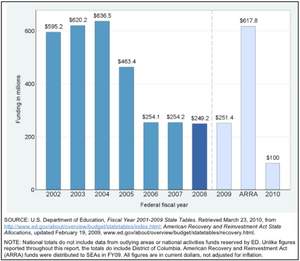WASHINGTON, DC--(Marketwire - April 22, 2010) - The State Educational Technology Directors Association (SETDA) today released its seventh annual National Educational Technology Trends Report, sharing new data on the increasingly important role that technology is playing in K-12 school improvement efforts in local communities in each of the 50 states. The report provides further evidence of the critical difference that national investments in educational technology are making in ensuring that all students are prepared for college and 21st century careers, that educators are able to effectively meet the needs of all students, and that every state is able to scale up innovations with broad potential for making systemic improvements in teaching and learning, increasing responsiveness to changing expectations for public education, and for realizing cost-savings.
"We have an unprecedented opportunity and obligation to help all students succeed in the 21st century," said Douglas Levin, Executive Director of SETDA. "As Secretary of Education Arne Duncan has said, 'Schools can't be throw‐backs to the state of education fifty, twenty, or even ten years ago.' This new study shows why the reauthorization of Elementary and Secondary Education Act (ESEA) must strengthen state and local educational technology leadership and capacity if we are serious about providing all students the opportunity to experience a world-class education."
The 34-page national report is available online at www.setda.org. Individual state profiles for every state, including examples from many local communities across the country, can be accessed online from www.setda.org/web/guest/statemembers.
Five State Educational Technology Leadership Trends
The 2010 SETDA National Educational Technology Trends Report, Innovation through State Leadership, identifies five trends in educational technology leadership through the Enhancing Education Through Technology (EETT) program:
- Scaling Up Success. States continued to provide educational technology leadership by focusing EETT investments on student-centric, research-based, technology-rich learning environments that advance state and federal goals.
- Enhancing Teacher Effectiveness. For the seventh year in a row, states reported offering a wide range of professional development - including coaching and mentoring - as a key leverage point for extracting a learning return on their EETT technology investments.
- Using Data to Inform Learning, Teaching, and Leadership. EETT investments are increasing the capacity of educators to access, analyze, and use data effectively to inform learning, teaching, and leadership.
- Increasing Academic Achievement. EETT investments continue to focus on technology-enhanced teaching and learning innovations that demonstrate positive gains in the core academic areas.
- Driving Innovation and New Educational Models. Educators are taking advantage of EETT investments in Web 2.0, interactive technologies, and broadband, by embracing technology-enhanced learning strategies that include online learning, use of open and digital content, and web-based professional communities of practice.
Unique Role of the Enhancing Education Through Technology (EETT) Program
The Enhancing Education through Technology program, or Title II, Part D of the Elementary and Secondary Education Act, is the only federal education program that supports meaningful uses of educational technology in classrooms and schools nation-wide. It serves as a complement to investments through other federal and state programs -- including the E-Rate, Title I, and IDEA -- and sets the national expectation that every student be technologically literate by the end of the eighth grade. Federal appropriations for the program have varied from year to year (see figure), and a broad coalition of organizations is currently seeking a federal appropriation of at least $500 million for fiscal year 2011.
Every state distributes program funds to the highest need schools through a mixture of competitive and formula grants to school districts. In addition, the 2010 SETDA National Educational Technology Trends Report reveals that the EETT program:
- Disproportionately supports technology integration and use at the middle and high school levels, in contrast to the Title I program which historically has focused investments at the elementary school level;
- Offers states and school districts the flexibility to invest in innovations that meet local needs, as evidenced by the net increase of transfers of federal dollars into EETT from other eligible federal program (particularly from the Improving Teacher Quality State Grants Program, Title II, Part A); and,
- Focuses on high-quality implementation and sustainability by supporting a large proportion of multi-year competitive grants to individual school districts and to consortia of school districts.
"State educational technology directors are increasingly focusing on systemic approaches to using technology to meet student achievement goals by building the technology integration skills of educators through high-quality professional development and through the use of data to inform instruction," said Christine Fox, SETDA Director of Professional Development and Research. "Scaling up from successful programs, many states are beginning to provide on-going professional development through the use of technology coaches, or Technology Integration Specialists, who support teaching and learning in the core content areas."
For Further Information
Douglas Levin, Executive Director of SETDA, is available for comment. If you are interested in setting up an interview, please contact Sara Hall at shall@setda.org or 410-279-3368.
About the State Educational Technology Directors Association
Founded in 2001, the State Educational Technology Directors Association (SETDA) is the principal association representing the technology leadership of state departments of education. The SETDA membership includes educational technology directors from the state departments of education of all fifty states, the District of Columbia, Bureau of Indian Affairs, American Samoa and the US Virgin Islands. See www.setda.org for more information.
To view the 34-page national report click here: http://media.marketwire.com/attachments/201004/5802_NationalTrendsReport2010Final_042110.pdf
Contact Information:
Contact:
Sara Hall
(410) 279-3368
